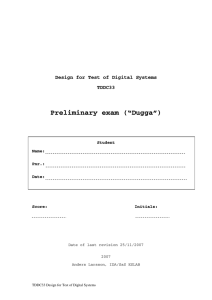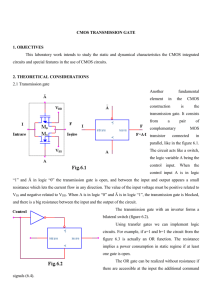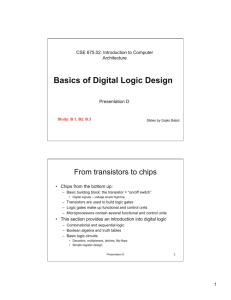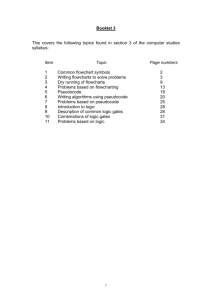Sheets on the Logic Trainers.
advertisement
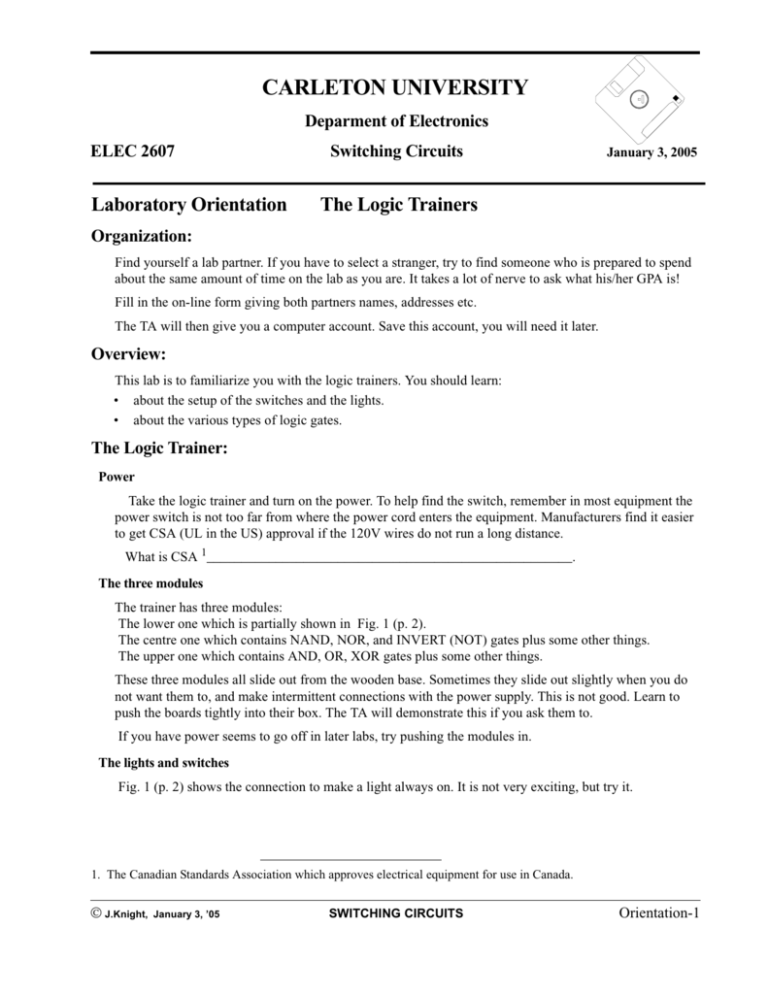
CARLETON UNIVERSITY Deparment of Electronics ELEC 2607 Laboratory Orientation Switching Circuits January 3, 2005 The Logic Trainers Organization: Find yourself a lab partner. If you have to select a stranger, try to find someone who is prepared to spend about the same amount of time on the lab as you are. It takes a lot of nerve to ask what his/her GPA is! Fill in the on-line form giving both partners names, addresses etc. The TA will then give you a computer account. Save this account, you will need it later. Overview: This lab is to familiarize you with the logic trainers. You should learn: • about the setup of the switches and the lights. • about the various types of logic gates. The Logic Trainer: Power Take the logic trainer and turn on the power. To help find the switch, remember in most equipment the power switch is not too far from where the power cord enters the equipment. Manufacturers find it easier to get CSA (UL in the US) approval if the 120V wires do not run a long distance. What is CSA 1_____________________________________________________. The three modules The trainer has three modules: The lower one which is partially shown in Fig. 1 (p. 2). The centre one which contains NAND, NOR, and INVERT (NOT) gates plus some other things. The upper one which contains AND, OR, XOR gates plus some other things. These three modules all slide out from the wooden base. Sometimes they slide out slightly when you do not want them to, and make intermittent connections with the power supply. This is not good. Learn to push the boards tightly into their box. The TA will demonstrate this if you ask them to. If you have power seems to go off in later labs, try pushing the modules in. The lights and switches Fig. 1 (p. 2) shows the connection to make a light always on. It is not very exciting, but try it. 1. The Canadian Standards Association which approves electrical equipment for use in Canada. J.Knight, January 3, ’05 SWITCHING CIRCUITS Orientation-1 Carleton University On Fig. 1 (p. 2) draw the connections to turn another light on from a push button ( pulse outputs). Make the connection and try circuit. Is the push-button output “1” when it is pushed or not pushed ? FIGURE 1 The face of part of the lower module CLOCK OUTPUT PULSE OUTPUTS CONSTANT OUTPUTS SWITCH OUTPUTS 1 HIGH LAMP INPUTS 0 LOW 1 2 3 TEKTRON COMPUTER LOGIC LAB 1 2 3 4 5 6 7 8 9 10 On the same figure draw the connections to turn another light on from a switch. Note the switch outputs are at the top, slightly removed from the switches. Make the connection and try the circuit. Is the switch output “1” when it is up or down. ? On the same figure, draw a connection from a light to the clock output. Connect a light to the clock output. Put the switch on high and on low and turn the knob. Describe what the clock output does.____________________________________________________ _________________________________________________________________________________ Gates FIGURE 2 Complete the list below, of the gate names and the number of gates of each type on the board. dual 2-input, sum of products 2-input AND 4 available Orientation-2 3-input AND 3 available 2-input OR 4 available 2-input XOR 4 available SWITCHING CIRCUITS 4 available J.Knight, January 3, 2005 Remove previous wires. Then wire a 2-input AND so that the inputs are from switches and the output is to a light. Complete the truth table below. A B 0 0 0 1 1 0 1 1 F A B F Complete the truth tables of the other gates below. A B A A B F B F A A B F B F A B F E A B F A B 0 0 0 0 0 0 0 0 0 1 0 1 0 1 0 1 1 0 1 0 1 0 1 0 1 1 1 1 1 1 1 1 F F Open inputs Take an AND gate with no connections. Connect its output to a light. Is it high or low?_______ The logic used on these boards is of a type called TTL. Is default input-logic-value with no external connections is one. If you do not find approximately this open-circuit input voltage a TTL gate is probably bad. Unfortunately if you do find it, the gate may still be bad. Connect a light to an input of an unused gate. If the light does not light, the gate is probably defective. Unfortunately this does not work on the logic trainers with squares around the lights. Other types of logic are different. A type called CMOS may overheat if inputs are left open. It will certainly give unpredictable values. J.Knight,January 3, ’05 SWITCHING CIRCUITS Orientation-3 PULSE OUTPUTS CONSTANT OUTPUTS SWITCH OUTPUTS 1 Partial Layout of 1 You should not need the JK flip-flops and RS latches which were omitted. LAMP INPUTS 0 The Tektron Logic Lab. 2 3 TEKTRON COMPUTER LOGIC LAB 1 J.Knight, January 3, ’05 Orientation-4 2 3 4 5 6 7 8 9 10 DIGITAL ELECTRONICS




